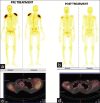Differential response of idiopathic sporadic tumoral calcinosis to bisphosphonates
- PMID: 25143910
- PMCID: PMC4138909
- DOI: 10.4103/2230-8210.137511
Differential response of idiopathic sporadic tumoral calcinosis to bisphosphonates
Abstract
Context: Tumoral calcinosis is a disorder of phosphate metabolism characterized by ectopic calcification around major joints. Surgery is the current treatment of choice, but a suboptimal choice in recurrent and multicentric lesions.
Aims: To evaluate the efficacy of bisphosphonates for the management of tumoral calcinosis on optimized medical treatment.
Settings and design: The study was done in the endocrine department of a tertiary care hospital in South India. We prospectively studied two patients with recurrent tumoral calcinosis who had failed therapy with phosphate lowering measures.
Materials and methods: After informed consent, we treated both patients with standard age adjusted doses of bisphosphonates for 18 months. The response was assessed by X ray and whole body 99mTc-methylene diphosphonate bone scan at the beginning of therapy and at the end of 1 year. We also estimated serum phosphate levels and urinary phosphate to document serial changes.
Results: Two patients (aged 19 and 5 years) with recurrent idiopathic hyperphosphatemic tumoral calcinosis, following surgery were studied. Both patients had failed therapy with conventional medical management - low phosphate diet and phosphate binders. They had restriction of joint mobility. Both were given standard doses of oral alendronate and parenteral pamidronate respectively for more than a year, along with phosphate lowering measures. At the end of 1 year, one of the patients had more than 95% and 90% reduction in the size of the lesions in right and left shoulder joints respectively with total improvement in range of motion. In contrast, the other patient (5-year-old) had shown no improvement, despite continuing to maintain normophosphatemia following treatment.
Conclusions: Bisphosphonate therapy in tumoral calcinosis is associated with lesion resolution and may be used as a viable alternative to surgery, especially in cases with multicentric recurrence or treatment failure to other drugs.
Keywords: Bisphosphonates; fibroblast growth factor 23; hyperphosphatemia; tumoral calcinosis.
Conflict of interest statement
Figures


References
-
- Fukumoto S. Physiological regulation and disorders of phosphate metabolism--pivotal role of fibroblast growth factor 23. Intern Med. 2008;47:337–43. - PubMed
-
- Slavin RE, Wen J, Barmada A. Tumoral calcinosis--a pathogenetic overview: A histological and ultrastructural study with a report of two new cases, one in infancy. Int J Surg Pathol. 2012;20:462–73. - PubMed
-
- Alkhooly AZ. Medical treatment for tumoral calcinosis with eight years of follow-up: A report of four cases. J Orthop Surg (Hong Kong) 2009;17:379–82. - PubMed
-
- Garringer HJ, Fisher C, Larsson TE, Davis SI, Koller DL, Cullen MJ, et al. The role of mutant UDP-N-acetyl-alpha-D-galactosamine-polypeptide N-acetylgalactosaminyltransferase 3 in regulating serum intact fibroblast growth factor 23 and matrix extracellular phosphoglycoprotein in heritable tumoral calcinosis. J Clin Endocrinol Metab. 2006;91:4037–42. - PubMed
LinkOut - more resources
Full Text Sources
Other Literature Sources

